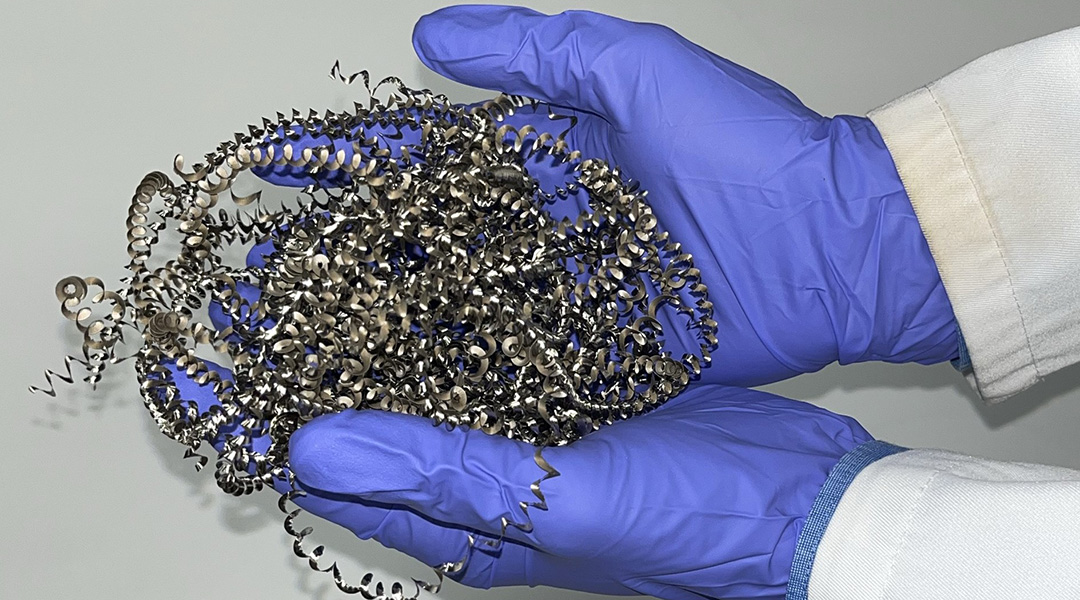There is an urgent need for clean fuel to generate heat and power vehicles. But if the production of that fuel relies on burning fossil fuels or depleting rare materials, the environmental solution is incomplete. Hydrogen falls into this category; it is a clean fuel that produces only water vapor when burnt, but we lack affordable, scalable green production methods.
A new approach promises to not just dramatically improve a clean production pathway, but also makes use of industrial waste material that would otherwise be discarded.
Water could provide a limitless hydrogen supply, but like sea water to a thirsty sailor, it gives hope with no relief if you cannot separate out the component parts. Electrolysis, which splits water into oxygen and hydrogen, is one of the most promising routes to hydrogen production but requires rare and expensive elements like platinum to catalyze the splitting.
Researchers from the University of Nottingham have discovered that the surface of swarf, the waste metal ringlets discarded by the metal machining industry, is textured at a nanoscale level in a way that boosts the catalysis, reducing the need for rare metals.
The authors of the study, published in the Journal of Material Chemistry A, claim it overcomes two major challenges. “Firstly, it enables the production of green hydrogen using the least amount of precious metal possible, and secondly, it upcycles metal waste from the aerospace industry, all in a single process,” said one of the study’s authors, Andrei Khlobystov.
These benefits compound the fundamental advantages of providing an alternative to polluting and non-renewable fuels, so could help us on the path to a more sustainable future.
Adding waste to water
“Industries in the UK alone generate millions of tons of metal waste annually,” said Jesum Alves Fernandes who led the research team. They thought this waste might be worth a closer look. “By using a scanning electron microscope, we were able to inspect the seemingly smooth surfaces of the stainless steel, titanium, or nickel alloy swarf.
“To our astonishment, we discovered that the surfaces had grooves and ridges that were only tens of nanometres wide. We realized that this nanotextured surface could present a unique opportunity for the fabrication of electrocatalysts.”
They sprinkled tiny amounts of platinum atoms over the swarf’s surface, which combined together into nanoparticles that fit perfectly into the nanoscale grooves. This snug fit increases the efficiency of the catalyst by maximizing the surface area of platinum that comes into contact with the water. More surface area means more points where the hydrogen-releasing reaction can occur.
The team’s experiments revealed that different types of swarf combined to different effect with platinum or cobalt, allowing them to refine the combination and optimize the process, ultimately dramatically reducing the amount of catalyst required.
“It is remarkable that we are able to produce hydrogen from water using only a tenth of the amount of platinum loading compared to state-of-the-art commercial catalysts,” said study co-author Madasamy Thangamuthu. “By spreading just 28 micrograms of the precious metal over 1 cm² of the swarf, we were able to create a laboratory-scale electrolyzer that operates with 100% efficiency and produces 0.5 liters of hydrogen gas per minute just from a single piece of swarf.”
Sustainable and scalable
This shift in efficiency of water electrolysis could transform the industry. Most methods for hydrogen production currently involve significant use of fossil fuels — the most common of which heats natural gas with steam and produces carbon dioxide as a byproduct.
If electrolysis can become economically viable and environmentally sustainable, it could replace these processes, providing a double benefit of reducing the need for non-renewable fuels, and removing fossil fuel combustion from the production pathway of a renewable non-polluting fuel. The recycling of waste material from other industries is an additional bonus, further emphasizing both the economic and environmental sustainability.
“Developing hydrogen propulsion systems can be a significant step towards addressing some of the world’s most pressing zero-carbon challenges, especially for the transport and manufacturing industries,” said study co-author Tom Rodden. “However, this strategy’s success depends on producing green hydrogen sustainably, such as through water splitting via electrolysis, and this, in turn, requires advancements in materials design.”
The research team are now working with industry partners in hopes that scaling up the technique will grow the economic and environmental benefits as widely as possible, ultimately turning (almost) nothing but trash and water into clean, renewable fuel.
Reference: Madasamy Thangamuthu, Jesum Alves Fernandes, et al., From scrap metal to highly efficient electrodes: harnessing nanotextured surface of swarf for effective utilisation of Pt and Co for hydrogen production, Journal of Materials Chemistry A (2024). DOI: 10.1039/d4ta00711e; quotes adapted from press release provided by the University of Nottingham
Feature image credit: University of Nottingham

















